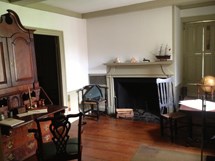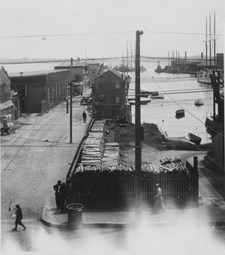|
Introduction The History of the Counting House The Excavation Further Reading (including a digital copy of the final report) The History of the Derby Counting House 
NPS photo During the 1750s and 1760s, Elias Hasket Derby was a rising young merchant, the second son of one of the most successful merchant-captains in pre-revolutionary Salem. Acting as what today we would consider a junior partner in his father's merchant house, Hasket (as he was known to his family) handled correspondence and trading voyages most likely from his father's counting house. However, just as marriage and moving into a home of his own established Hasket as an adult member of Salem's 18th century society in 1762, the establishment of his own counting house, a business office where his ledgers and correspondence could be kept, meant that he was an independent merchant. A counting house also meant that he had space to employ a clerk, who could keep the books and write correspondence. Although we don't know precisely what year Hasket established his own counting house, 1784 is a strong possibility because his father died in 1783, and it took some time to settle the estate. Hasket had owned a warehouse on Derby Wharf since 1765, a 23 foot by 60 foot three-story building whose short end fronted the south side of Derby Street near the head of the wharf. Between May and November, 1784, Hasket had a chimney and hearth installed in the building, and at least part of the interior lathed and plastered. This would indicate that the warehouse was meant to have people in it on a regular basis, since warehouses did not normally have heat.The best evidence that we have as to the location and description of the building comes from the diaries of Rev. William Bentley, a local minister. On September 24, 1789, he noted "Mr. Derby has repaired his store at the head of the wharf,& glazed the front, so as to give it a very improved appearance . . ." The installation of windows in the Derby Street side of the building is supported by a receipt for "making two window frames and sashes" in the Derby Papers. Bentley also tells us where the counting house was located on May 7, 1791. "Last night an attempt was made to break open the stores of Mr. Gray and E. H. Derby. . . . At the last, entry was made by the western door, by forcibly breaking the bolt from the lock. They then went upstairs, & had taken a pane of glass from the counting house door, when the light they had was espied by a guard . . ." Thus, we know the counting house was on the second floor, but walled off from the rest of the floor and with a door that had glass in it. The furnishings of the room were probably quite simple; a desk, tables, chairs, and a bookcase either on top of the desk or separate to store ledgers and papers. 
NPS Collections. Photograph by Phillip Mason Little. When Hasket died in 1799, the counting house, along with the rest of the wharf was inherited by his children. The counting house continued to be used as a warehouse until 1819, when the construction of the new Custom House required space for material storage and construction staging. To make room, John Derby, who owned the warehouse, hired a workman "to take down his store at the North end of Derby Wharf and remove all the materials . . . to fill up under it with mud and gravel, to have it when settled as high as the land east of said store." Since that time, that lot has been empty, used for storage of lumber during the mid and late 19th century, and then as a staging area for restoration of Derby Wharf by the National Park Service in the late 1930s.
|
Last updated: February 26, 2015
